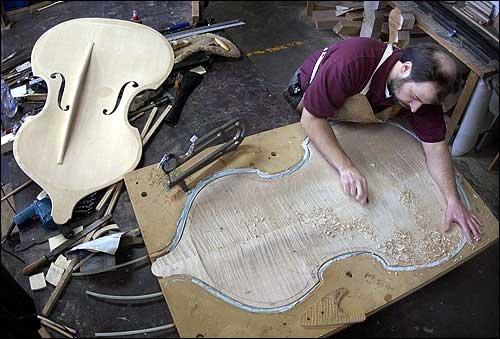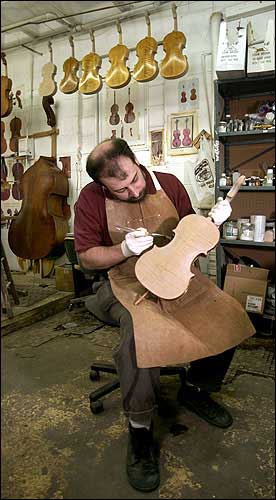Orchestra constructor makes pitch for $1 million matched set
MERRIAM ? For sale: one set of 62 violins, violas, cellos and basses.
The price tag is just shy of $1 million, but the results will go toward answering a riddle of music history, so the purchaser’s name will live on for years.
That’s the pitch instrument maker Anton Krutz is using as he tries to make a 5-year-old dream into a reality.
Krutz, who repairs, restores and makes professional quality stringed instruments in suburban Kansas City, is looking for a sponsor for a set of instruments he says will recreate on a large scale the type of interlocking tones the chamber orchestras and other musical groups produced more than 200 years ago.
Interlochen Center for the Arts, one of the nation’s foremost academies for young musicians, already has agreed to provide a home for the set, lending it to its best student orchestras.
But Krutz, who has made presentations to corporations and foundations, has yet to get the $950,000 check he’s looking for.
“I think everyone sees the opportunity,” he said. “I’m not discouraged. I think it will happen.”
Krutz’s quest began five years ago when he was entertaining some musicians at his shop.
A couple of visitors picked up some of Krutz’s instruments and began to play. The notes were no different from any other performance, but Krutz said there was a sublime deepness to the music, a resonance between the instruments that he felt in his chest.

Anton Krutz carves a slab of maple to form the back plate of a bass in his Merriam shop. Krutz is hoping to find a sponsor to pay nearly million for a matched set of his violins, violas, cellos and bases, which he believes will recapture the orchestral sounds of 200 years ago.
“The sound weighs more; it sounds bigger — almost like a woofer,” he said.
Enthralled, Krutz wondered what it would sound like if an entire orchestra was playing with his instruments.
In the 1600s and 1700s, it was common for chamber orchestras and other groups to perform on instruments from a single maker as most groups were outfitted by royalty or the church and used local artisans.
Krutz, 36, whose family emigrated from St. Petersburg, Russia, when he was about 7 years old, has been making stringed instruments for more than 20 years. Krutz opened his shop, KC Strings, in 1992 with the help of his father, Michael “Misha” Krutz and their partner, Richard Williams.
Besides repair work and restoration, the shop and its 15 employees make the full range of orchestral stringed instruments, including the huge double basses, which are normally made separately from violins, violas and cellos.
Musicians from such orchestras as the Boston Symphony and the New York Philharmonic play Krutz instruments. Professional-grade violins start at $10,000.
With such a reputation, Krutz found a willing partner in Interlochen, based in Interlochen, Mich.
School President Jeffrey Kimpton said many students come with great talent but sometimes poor instruments. He said he readily agreed to provide a home for the so-called “symphonic set” of instruments Krutz wants to produce.
“It has people’s juices flowing,” Kimpton said. “For our kids to be able to play a matched set would be an exciting venture for everybody.”
Krutz explains the idea by imagining the orchestra as a chorus.
“That’s the uniqueness of stringed instruments — when played by the best people, can create their own voice,” he said. “A regular string orchestra is like a regular choir, all individual voices. But a set of instruments made by the same person … all the people in the choir are genetic twins. It’s not 60 instruments, it’s one voice encompassing all ranges of sound.”

Anton Krutz varnishes a handmade violin in his Merriam shop. Krutz is hoping to find a sponsor to pay nearly million for a matched set of violins, violas, cellos and basses, which he believes will recapture the orchestral sounds of 200 years ago.
But the plan has its skeptics.
Tim Olsen is editor of American Lutherie, the journal of the Guild of American Luthiers, or people who made stringed instruments. Olsen said the idea of a matched set of orchestral instruments is intriguing.
But he said setting up an experiment to truly show if there was a difference in sound would be “next to impossible,” given the subjectivity of human ears, the differences in performance quality and the need for blind tests and controls.
He also said that there were other ways to test the theory without commissioning a new set of instruments, such as piecing together an orchestra from existing instruments or evaluating the sound differences in smaller groups.
“There are a number of highly paid string quartets out there,” Olsen said. “If this was desirable, you would expect to see them seek this out.”
Edward Campbell, a luthier in Boiling Springs, Penn., and a board member of the Violin Society of America, said it would be hard to produce that many instruments in a reasonable time without hurting the quality. That said, Campbell said he would love to hear the results.
“I think if you can provide the instruments, a major orchestra would jump on it,” he said.
Krutz denies that his concept is mere marketing. He said professional musicians don’t buy $20,000 cellos based on the brand name, relying more on word of mouth and what their colleagues use.
He said his is an honest attempt to see if the orchestras of old had something that modern ensembles lack. But if it fails — and this is where he uses the “no such thing as bad publicity” pitch with potential sponsors — the instruments aren’t going anywhere.
“The worst-case scenario is you have a beautiful sound and the critics argue whether it sounds different,” he said. “Let the critics argue.”






